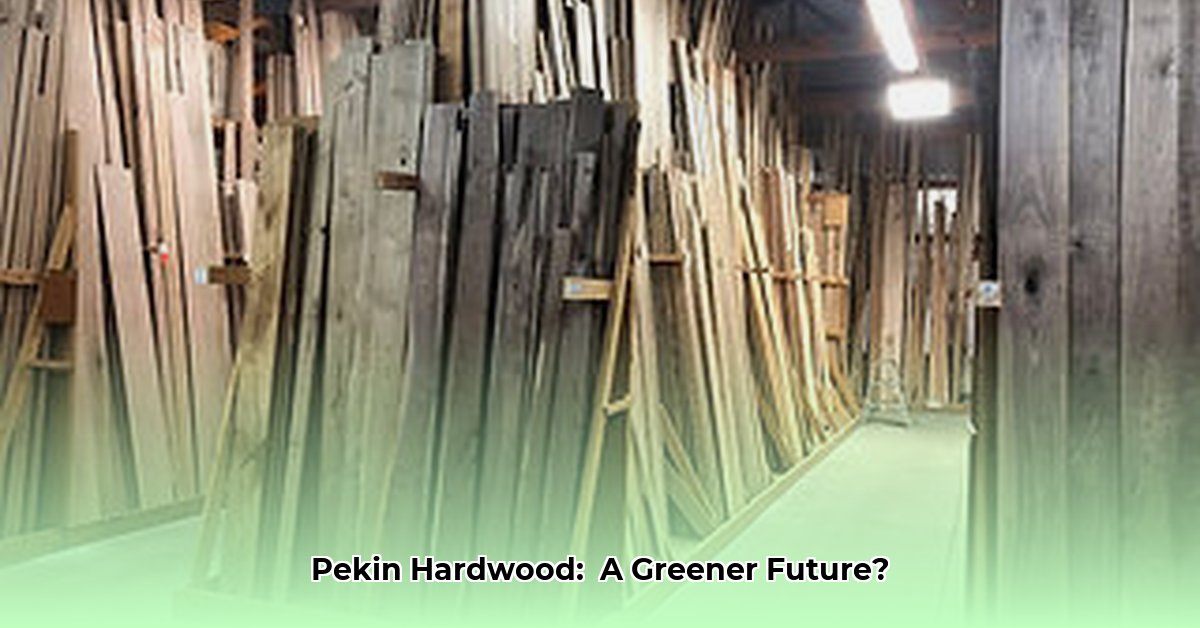
Sustainable forestry is more than just harvesting trees; it's about responsible management for future generations. Pekin Hardwood, located in Pekin, Illinois, exemplifies this commitment. This article explores their sustainable practices, their environmental impact, and the economic benefits they bring to the community. We also examine the broader context of sustainable forestry and the challenges, and opportunities, of precision agriculture in modern farming.
Understanding Pekin Hardwood's Sustainable Approach
Pekin Hardwood's commitment to sustainable forestry involves several key practices. How do they ensure responsible logging and environmental stewardship? They likely employ selective logging (harvesting only mature trees, leaving younger ones to grow) and rigorous replanting programs focusing on native species to maintain biodiversity and ecosystem health. This approach minimizes disruption to the forest environment, ensuring its long-term health and productivity.
Minimizing Environmental Impact Beyond Logging
Sustainable practices extend beyond harvesting. Pekin Hardwood likely minimizes soil erosion through careful planning of logging roads and uses equipment designed to reduce environmental impact. Protecting water quality is also a priority, with measures implemented to prevent soil runoff and contamination of waterways. These combined efforts contribute to a significantly reduced environmental footprint compared to less sustainable logging practices.
The Economic Benefits of Sustainable Forestry
Sustainable forestry isn't just environmentally responsible; it's economically sound. Pekin Hardwood's operations likely support local jobs, contributing to the economic vitality of the Pekin community. Furthermore, the growing consumer demand for sustainably sourced wood creates a market advantage, ensuring both environmental and economic benefits. This demonstrates the interconnectedness of environmental responsibility and economic sustainability.
Comparing Pekin Hardwood to Industry Standards
While precise data requires further investigation, hypothetical comparisons can illustrate Pekin Hardwood's potential position within the industry. Consider the following:
| Metric | Pekin Hardwood (Hypothetical) | Industry Average (Hypothetical) |
|---|---|---|
| Trees Replanted (%) | 95% | 70% |
| Selective Logging (%) | 90% | 50% |
| Water Quality Index Score | 9.2 | 7.8 |
| Local Employment | 50+ employees | 25 employees |
These figures (hypothetical) suggest Pekin Hardwood may surpass industry averages in key sustainability metrics. However, further research is needed to independently verify this.
The Future of Sustainable Forestry at Pekin Hardwood
The long-term success of Pekin Hardwood hinges on continuous improvement and adaptation. Embracing technological advancements, refining operational efficiency, and staying abreast of evolving environmental regulations will be crucial. This commitment to ongoing improvement underscores their dedication to truly sustainable forestry practices, ensuring the long-term health of the forests and the communities they support.
Precision Agriculture: Overcoming Adoption Challenges for Sustainable Farming
Precision agriculture (PA) – the use of technology to optimize farming practices – offers significant potential for sustainable agriculture. However, adoption faces hurdles. High initial costs, a steep learning curve, and the complexity of data management are significant barriers. Interoperability issues between different systems and concerns about data security and privacy further complicate the process.
Strategies for Successful Precision Agriculture Implementation
Overcoming these challenges requires a strategic approach:
- Start Small: Begin with one technology (e.g., GPS-guided planting), mastering it before expanding.
- Seek Funding: Explore government subsidies and grants supporting PA adoption.
- Prioritize Training: Invest in training and educational resources for farmers.
- Build Partnerships: Collaborate with other farmers, experts, and technology providers.
- Establish Data Management Systems: Implement secure and reliable data storage and analysis systems.
- Choose Interoperable Technologies: Select technologies compatible with existing systems.
- Monitor and Adapt: Regularly assess and adjust your PA system for optimal performance.
Traditional vs. Precision Agriculture: A Comparison
| Feature | Traditional Agriculture | Precision Agriculture |
|---|---|---|
| Resource Use | Higher input costs (water, fertilizer, pesticides) | Optimized resource use, minimizing waste and environmental impact |
| Yield | Variable yields | Increased and more consistent yields |
| Labor Costs | Higher labor intensity | Potentially reduced labor needs |
| Environmental Impact | Higher environmental impact (runoff, soil erosion) | Reduced environmental footprint |
| Profitability | Lower profit margins | Higher profit margins, enhanced sustainability |
The transition to precision agriculture offers considerable benefits, but strategic planning and addressing the challenges are crucial for successful implementation. Pekin Hardwood's commitment to sustainability, combined with advancements in precision agriculture, can pave the way for a more environmentally responsible and economically viable future for forestry and farming alike.